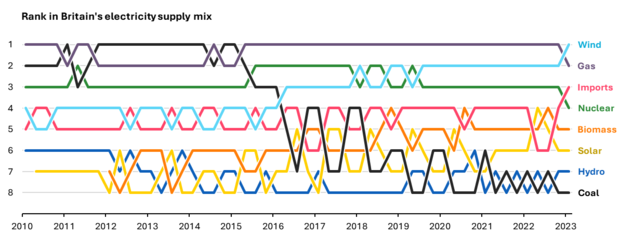There’s a “renewable power revolution” occurring, and in the U.K., it’s working. For the time ever, wind energy provided more power to the country than gas.
The milestone energy sourcing occurred during the first three months of 2023, a new report published on Wednesday said. According to the report, published by Drax Electric Insights and conducted by researchers at Imperial College London, 32.4% of Britain’s electricity came from wind power during that time. Turbines generated 24 terrawatt-hours (Twh) of electricity, an amount that could charge more than 300 million Tesla Model Ys, researchers said, and an amount that was 3% higher than the output generated at the same time last year.
Gas, on the other hand, generated 31.7% of the nation’s energy and was down 5% from the same time last year.
“It is the first-time wind has provided the largest share of power in any quarter in the history of the country’s electricity grid,” a press release for the report says.
And this was just one part of renewable energy’s continued takeover of fossil fuels for the No. 1 spot in the U.K.’s power sourcing, which happened for the first time in 2020, according to the U.S. Energy Information Administration. That year, the country generated 46% of its power from renewable electricity, which includes solar, biomass and hydro, and 38% from fossil fuels. This year, they accounted for 42% and 33%, respectively.
Iain Staffell, a scientist and researcher at Imperial College who led the report, said this transformation is due to the “renewable power revolution.”
“In the space of a decade the UK has almost completely cut out coal, after relying on the most polluting fossil fuel for over a century to power our country,” he said. “There are still many hurdles to reaching a completely fossil fuel-free grid, but wind out supplying gas for the first time is a genuine milestone event, and shows what can be achieved when governments create a good environment for investors in clean technology.”
Coal production has also fallen substantially, decreasing more than 90% from 2010 to 2020, the EIA said. And according to the Drax report, it’s the smallest source of electricity overall, with just a single coal power plant left, and many previous fossil fuel-burning plants now focused on renewables.

Drax Electric Insights
The latest report is just part of a global push for renewable energy, as experts warn that the planet may exceed 1.5 degrees Celsius of warming above pre-industrial times within the next few years. This threshold, climate scientists and the United Nations have repeatedly warned, would greaten the risk of extreme weather, sea level rise, temperatures, droughts and other weather and climate events.
The burning of fossil fuels, such as gas and coal, greatly contributes to global warming, as that process releases carbon dioxide and other gases that trap heat within the planet. Renewable energy, on the other hand, does not.
Last month, environmental non-profit think tank Ember published a report that found wind and solar power increased by 19% globally in 2022, a surge that, if continued, could “push the world into a new era of falling fossil generation” as soon as this year. Comparatively, coal generation increased by just 1.1% that year, while gas decreased by 0.2%.
That data was compiled based on electricity data from 78 countries that generate 93% of the world’s electricity demand, the report said.
“Clean power growth is likely to exceed electricity demand growth in 2023,” the report said. “This would be the first year for this to happen outside of a recession…A new era of falling power sector emissions is close.”
Li Cohen 
Li Cohen is a social media producer and trending content writer for CBS News.
